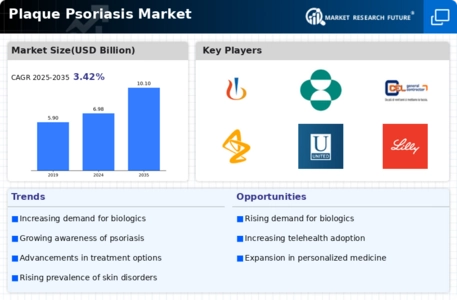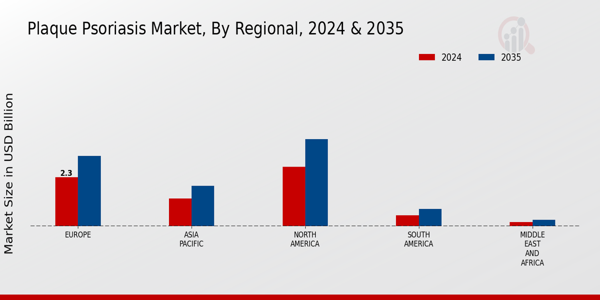Rising Awareness and Education
There is a noticeable increase in awareness and education surrounding plaque psoriasis, which appears to be influencing the Plaque Psoriasis Market positively. Campaigns aimed at educating both healthcare professionals and patients about the condition are becoming more prevalent. This heightened awareness may lead to earlier diagnosis and treatment, ultimately improving patient outcomes. Additionally, as patients become more informed about their treatment options, they are more likely to seek out advanced therapies, thereby increasing demand within the market. The role of patient advocacy groups in disseminating information and supporting individuals with plaque psoriasis cannot be understated, as they contribute significantly to the overall growth of the Plaque Psoriasis Market.
Advancements in Treatment Options
Recent advancements in treatment options for plaque psoriasis are likely to reshape the landscape of the Plaque Psoriasis Market. The introduction of novel biologics and targeted therapies has provided patients with more effective and safer alternatives compared to traditional treatments. For instance, biologics that target specific pathways in the immune system have shown promising results in clinical trials, leading to improved patient outcomes. The market for biologics is projected to grow significantly, with estimates indicating that it could account for over 50% of the total psoriasis treatment market by 2025. This shift towards more advanced therapies may not only enhance patient satisfaction but also stimulate competition among pharmaceutical companies, further driving innovation within the Plaque Psoriasis Market.
Integration of Digital Health Solutions
The integration of digital health solutions into the management of plaque psoriasis is emerging as a key driver in the Plaque Psoriasis Market. Telemedicine and mobile health applications are becoming increasingly popular, allowing patients to monitor their condition and communicate with healthcare providers more effectively. This trend is particularly relevant as it offers patients greater accessibility to care, especially in remote areas. Moreover, digital platforms can facilitate personalized treatment plans and improve adherence to prescribed therapies. The market for digital health solutions is expected to expand, with projections indicating that it could reach several billion dollars by the end of the decade. This evolution in patient care is likely to enhance the overall experience for individuals living with plaque psoriasis, thereby influencing the Plaque Psoriasis Market.
Increasing Prevalence of Plaque Psoriasis
The prevalence of plaque psoriasis appears to be on the rise, with estimates suggesting that approximately 2-3% of the population is affected by this chronic skin condition. This increase in cases is likely to drive demand within the Plaque Psoriasis Market, as more individuals seek effective treatment options. The growing awareness of the condition and its impact on quality of life may also contribute to heightened demand for therapies. Furthermore, the aging population, which is more susceptible to autoimmune diseases, could exacerbate this trend. As the number of diagnosed cases continues to grow, pharmaceutical companies may invest more in research and development, leading to a broader range of treatment options available in the Plaque Psoriasis Market.
Regulatory Support for Innovative Therapies
Regulatory support for innovative therapies is likely to play a crucial role in shaping the Plaque Psoriasis Market. Regulatory agencies are increasingly recognizing the need for expedited approval processes for new treatments, particularly those that demonstrate significant efficacy and safety. This trend is evident in the approval of several biologics and novel therapies in recent years, which have transformed the treatment landscape for plaque psoriasis. The potential for faster access to new therapies may encourage pharmaceutical companies to invest in research and development, ultimately leading to a more diverse range of treatment options for patients. As regulatory frameworks continue to evolve, they may foster an environment conducive to innovation within the Plaque Psoriasis Market.


















Leave a Comment